Cross-Scale Water and Land Impacts of Local Climate and Energy Policy—A Local Swedish Analysis of Selected SDG Interactions
Abstract
:1. Introduction
2. Materials and Methods
2.1. Study Area
2.2. Analytical Approach
2.2.1. Energy Model and Scenario Development
2.2.2. Mapping of CLEW Resource Interactions
2.2.3. Assessing Sensitivity and Scalability of Results
3. Results
3.1. Impact of Local Climate Targets on Energy, Water and Land Use
3.2. Geographical Distribution of Energy-Related Impacts on Water and Land Use
3.3. Sensitivity and Scalability of Local Case Results
3.3.1. Sensitivity Analysis for Cross-Resource Factors
3.3.2. Scaling to National Energy End Uses
4. Discussion
4.1. Cross-Resource and Cross-Scale Implications
4.2. SDG Relations and Interactions
4.3. Uncertainty Implications
5. Concluding Remarks
Supplementary Materials
Author Contributions
Funding
Acknowledgments
Conflicts of Interest
Appendix A. Model Design and Assumptions
Appendix A.1. Final Energy (Service) Demands
Appendix A.2. Energy Efficiency, Supply Technologies, and Fuel Availability
| Efficiency Measure | Efficiency Improvement by 2030 Compared to Baseline | Reference |
|---|---|---|
| Residential and commercial electrical appliances | 50% | [95] |
| Residential cooking energy intensity | 20% | [96] |
| Residential and commercial lighting | 85% | [70] |
| Residential and commercial building insulation—impacting total heating demand by… | 20% | [70] |
| Street light energy intensity | 50% | [97] |
| Energy intensity of industry | 38% | [76] finds potential to reduce by 40% compared to present level. Since the baseline energy intensity increases, this is a more conservative assumption. |
| Freight transport within the municipality | 10% reduction in vehicle-kilometres travelled by freight transports | This is a modest estimate by the authors based on unquantified ambitions to decrease the number of vehicle-kilometres travelled [51]. |
| Energy System Component | Technology/Fuel Switch | Reference |
|---|---|---|
| Industrial process heat | Fossil oil is replaced with (>80% biomass based) district heat and electricity (district heating assumed to be feasible up to 89% (modelled in the biofuels scenario). In the electricity scenario, electricity and district heating cover 50% each of the replaced oil heating demand. | Based on the patterns suggested by [76] |
| Freight transport and agricultural sector | All use of fossil diesel is replaced by biodiesel (pure FAME) | According to [98] the use of pure FAME based on RME is increasing. |
| Space Heating Technology | Baseline Scenario | ‘Electricity’ Scenario | ‘Biofuels’ + ‘Mixed’ Scenarios |
|---|---|---|---|
| Detached houses | % shares in 2030 | % shares in 2030 | % shares in 2030 |
| 50.6 | 65 | 65 |
| 3.6 | 4 | 4 |
| 45 | 23 | 23 |
| 0.8 | 0 | 0 |
| 0 | 8 | 8 |
| Apartments | |||
| 15.8 | 16 | 12 |
| 84 | 80 | 84 |
| 0.2 | 0 | 0 |
| 0 | 4 | 4 |
| Commercial buildings | |||
| 58 | 76 | 58 |
| 20 | 20 | 38 |
| 22 | 0 | 0 |
| 0 | 4 | 4 |
| Vehicle Fleet in Year… | 2012 | 2030 in Each Scenario: | |||
|---|---|---|---|---|---|
| Baseline | Electricity and Mixed | Biofuels | |||
| Personal Vehicles (no. of vehicles) | Diesel | 2262 | 7130 | 233 * | 1094 * |
| Gasoline | 10925 | 4942 | 310 | 310 | |
| Plug in electric | 61 | 94 | 1068 | 1463 | |
| Biogas | 34 | 150 | 444 | 6216 | |
| Ethanol | 653 | 2340 | 537 | 1468 | |
| Electric | 1 | 4 | 10986 | 3027 | |
| Total | 13936 | 14660 | 13577 | 13577 | |
| Public transport (no. of buses) | Diesel | 20 | 20 | 0 | 0 |
| Biogas | 0 | 0 | 7 | 37 | |
| Plug in electric | 0 | 0 | 35 | 5 | |
| Total | 20 | 20 | 42 | 42 | |
Appendix A.3. Water and Land-Use Impacts
| Fuel | Geographic Origin (of Fuel) | Consumptive Water Use (m3/TJ) | Geographic Origin of Reference | Reference | Land Use (ha/TJ) | Geographic Origin of Reference | Reference |
|---|---|---|---|---|---|---|---|
| Crude oil—refined to heating oil, gasoline and diesel | Russia | 133 | Spain | Calculated based on data from [79,99] | 0.1266 | Canada | Calculated based on reported data from [82]. |
| Electricity (incl. (nuclear) fuel extraction) | Sweden (Canada) | 2222 | Russia | Calculated from electricity generation factors per source fuel and the Swedish electricity mix.
| 0.266 | Nordic (Canada) | Calculated from electricity generation factors per source fuel [37,53,104] and the Swedish electricity mix [61]. |
| Wind power | Oskarshamn | 0 | USA / Global | Assumed negligible by [79,105]. | 3.47 | Oskarshamn | [53] |
| Biogas (if imported) | Oskarshamn (Sweden) | 0 (454) | Italy | Locally produced biogas is assumed to come from sewage sludge, manure and similar wet waste products (requiring no added water). Imported biogas may come from dry matter, therefore requiring water in the anaerobic process as assumed by [27] | 0 (5.6) | EU | [36] |
| Biomass (from forest residues) | Oskarshamn | 612 | USA | [106] | 2.5 | Spain | [107], assuming forest residues to “occupy” 5% of the land they are harvested from |
| Biomass (from Grass) | Oskarshamn | 0 | Sweden | Based on description in [108] | 8.4 | Oskarshamn | Swedish Biogas International AB (2008), assuming that the crop ”occupy” 70% of the land it is harvested from (assumption based on data patterns in [36]. |
| Ethanol from sugar cane | Brazil | 24695 | “Global average” | [81] | 5.0 | Latin America | [36] |
| Biodiesel from rapeseed | EU (Sweden and Germany) | 57047 | USA | [79] | 11.9 | EU | [36] |
- Solid biofuels (biomass) are included in the Oskarshamn energy model in two formats: forest based pellets or wood fuel for residential heating and district heating, and grassy biomass for biogas production (in conjunction with manure and municipal sewage) and for district heating. It is assumed that the grassy biomass is inserted in the energy system without pre-processing, thereby requiring no additional water. Further, the grass is expected to grow without irrigation. Conversion of forest biomass to pellets are considered to require some water.
- As highlighted in the main manuscript all data describing cross-resource interaction between water, land and energy are reported in large ranges. Data points selected to describe these relationships in the model are therefore to be interpreted as reasonable guesses rather than exact representations of the real interactions. See further discussion on sensitivity of results and need for further developments in data collection and modelling approaches in main manuscript.
Appendix A.3.1. References of Data Sources Reviewed for Energy Related Water Use and Land Use
- Pacetti, T., Lombardi, L. & Federici, G. Water-energy Nexus: a case of biogas production from energy crops evaluated by Water Footprint and Life Cycle Assessment (LCA). J. Clean. Prod. 101, 278–291 (2015).
- Mekonnen, M. M., Gerbens-Leenes, P. W. & Hoekstra, A. Y. The consumptive water footprint of electricity and heat: a global assessment. Environ. Sci. Water Res. Technol. 1, 285–297 (2015).
- Levi, L., Jaramillo, F., Andricevic, R. & Destouni, G. Hydroclimatic changes and drivers in the Sava River Catchment and comparison with Swedish catchments. Ambio 44, 624–634 (2015).
- Spang, E. S., Moomaw, W. R., Gallagher, K. S., Kirshen, P. H. & Marks, D. H. The water consumption of energy production: an international comparison. Environ. Res. Lett. 9, 105002 (2014).
- International Energy Agency. World Energy Outlook 2012. (OECD/IEA, 2012).
- Macknick, J., Newmark, R., Heath, G. & Hallett, K. C. Operational water consumption and withdrawal factors for electricity generating technologies: a review of existing literature. Environ. Res. Lett. 7, 045802 (2012).
- Herath, I., Deurer, M., Horne, D., Singh, R. & Clothier, B. The water footprint of hydroelectricity: a methodological comparison from a case study in New Zealand. J. Clean. Prod. 19, 1582–1589 (2011).
- Scown, C. D., Horvath, A. & McKone, T. E. Water Footprint of U.S. Transportation Fuels. Environ. Sci. Technol. 45, 2541–2553 (2011).
- Katers, J. F. & Snippen, A. Life-cycle Inventory of Wood Pellet Manufacturing in Wisconsin. 43 (Public Service Commission of Wisconsin & the Statewide Energy Efficiency and Renewables Administration, 2011).
- Granit, J. & Lindström, A. Constraints and opportunities in meeting the increasing use of water for energy production. in Proceedings of the ESF Strategic Workshop on: Accounting for water scarcity and pollution in the rules of international trade 54, (UNESCO-IHE Institute for Water Education, 2010).
- Mielke, E., Anadon, L. D. & Narayanamurti, V. Water consumption of energy resource extraction, processing, and conversion. (Belfer Center for Science and International Affairs, Harvard Kennedy School, Harvard University, 2010).
- Fthenakis, V. & Kim, H. C. Life-cycle uses of water in U.S. electricity generation. Renew. Sustain. Energy Rev. 14, 2039–2048 (2010).
- Rio Carrillo, A. M. & Frei, C. Water: A key resource in energy production. Energy Policy 37, 4303–4312 (2009).
- Gerbens-Leenes, W. & Hoekstra, A. Y. The water footprint of sweeteners and bio-ethanol from sugar cane, sugar beet and maize. (2009).
- Gerbens-Leenes, P. W., Hoekstra, A. Y. & Meer, T. H. Water footprint of bio-energy and other primary energy carriers. (UNESCO-IHE Institute for Water Education, 2008).
- Union of Concerned Scientists. UCS EW3 Energy-Water Database V.1.3. (2012).
- Swedenenergy. Fjärrvärmestatistik—Energiföretagen Sverige. (2015). Available at: http://www.svenskfjarrvarme.se/Statistik--Pris/Fjarrvarme/Energitillforsel/. (Accessed: 11th December 2017)
- Miljösamverkan Västra Götaland. Vägledning för miljötillsyn vid fjärrvärmeanläggningar. (2007).
- Vattenfall AB. Certified Environmental Product Declaration EPD® of Electricity from Vattenfall Nordic Nuclear Power Plants. (2016).
- Vattenfall AB. Certified Environmental Product Declaration EPD® of Electricity from Vattenfall Nordic Wind Farms. (2016).
- Vattenfall AB. Certified Environmental Product Declaration EPD® of Electricity from Vattenfall’s Nordic Hydropower. (2015).
- Valin, H. et al. The land use change impact of biofuels consumed in the EU. Quantification of area and greenhouse gas impacts. (ECOFYS, 2015).
- Energikontor Sydost & Biogas Sydost. Regional strategi och handlingsplan för biogas till fordon i Blekinge, Kalmar och Kronobergs län. Åtgärder 2014–2017 med utblick till 2020. Växjö (Energikontor Sydost AB, 2014).
- Yeh, S. et al. Land Use Greenhouse Gas Emissions from Conventional Oil Production and Oil Sands. Environ. Sci. Technol. 44, 8766–8772 (2010).
- Gómez, A., Rodrigues, M., Montañés, C., Dopazo, C. & Fueyo, N. The potential for electricity generation from crop and forestry residues in Spain. Biomass Bioenergy 34, 703–719 (2010).
- Fthenakis, V. & Kim, H. C. Land use and electricity generation: A life-cycle analysis. Renew. Sustain. Energy Rev. 13, 1465–1474 (2009).
- Denholm, P. & Margolis, R. M. Land-use requirements and the per-capita solar footprint for photovoltaic generation in the United States. Energy Policy 36, 3531–3543 (2008).
- Swedish Biogas International. Möjligheter för biogas i Kalmar län-en idéstudie. 88 (Swedish Biogas International, 2008).
Appendix B. Supplementary Figures
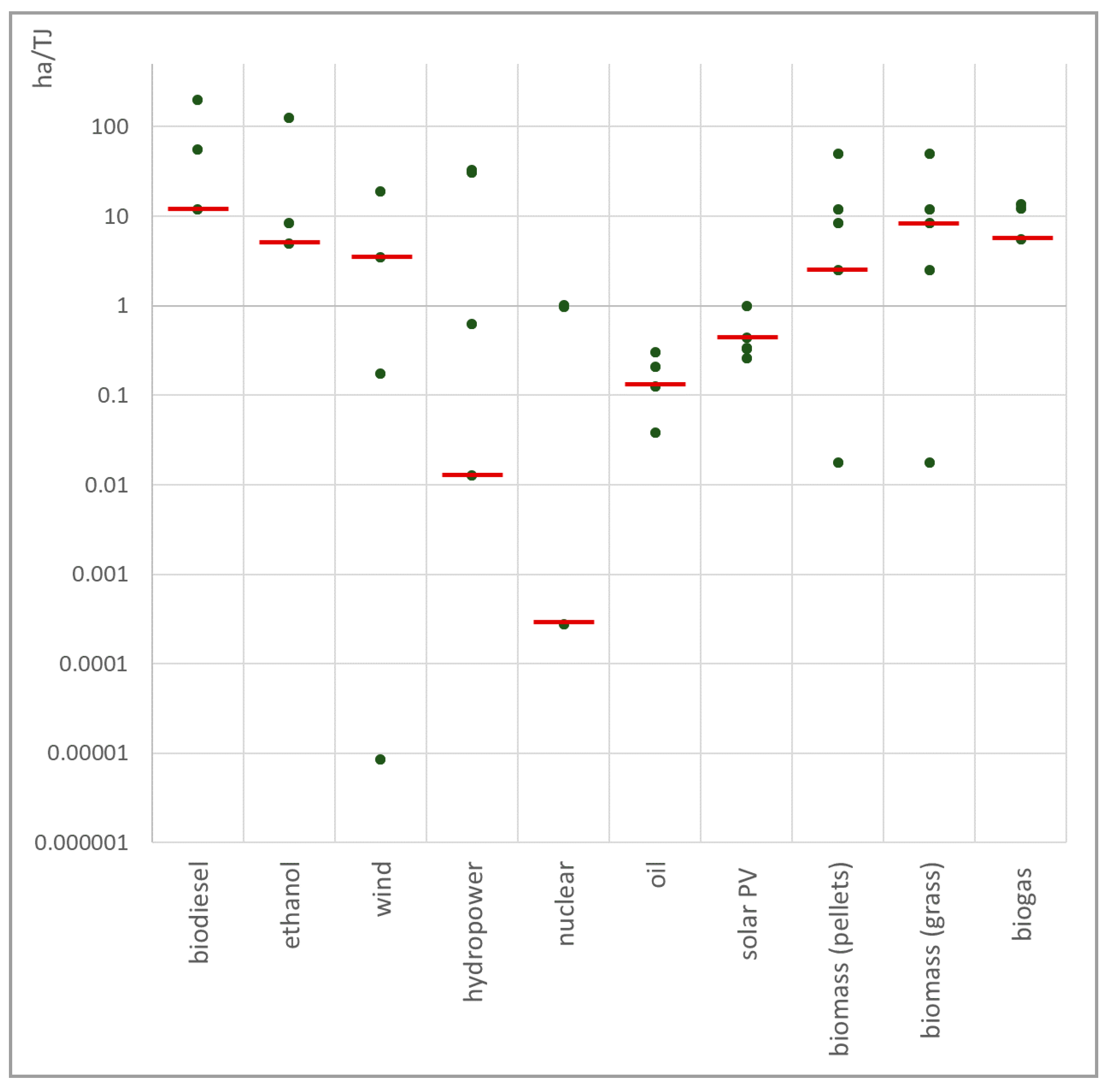
- Nuclear energy land use requirements are not including estimated land use needs for final repository of used fuel. It is therefore anticipated that the total land area excluded from other uses due to nuclear energy is larger than reported here.
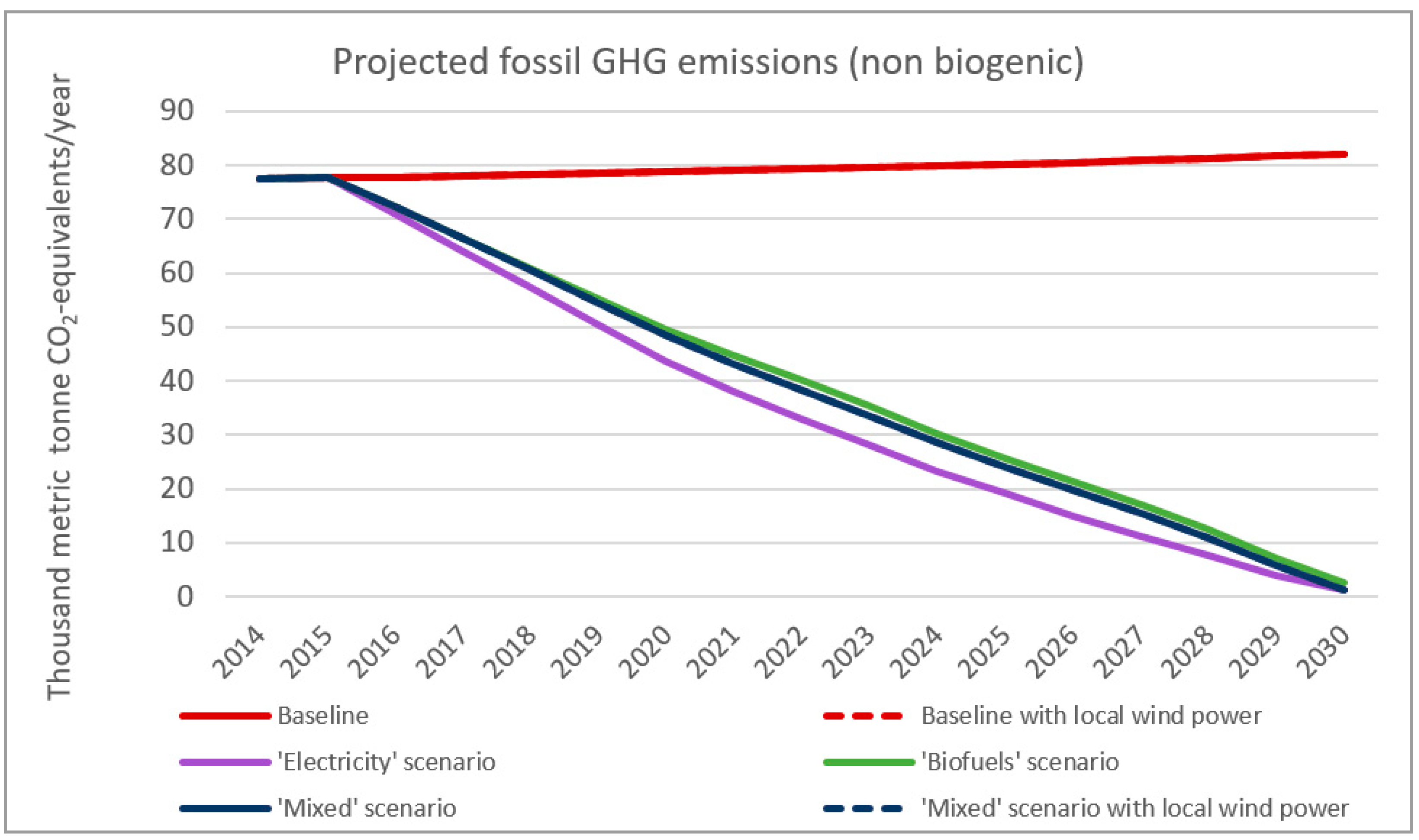

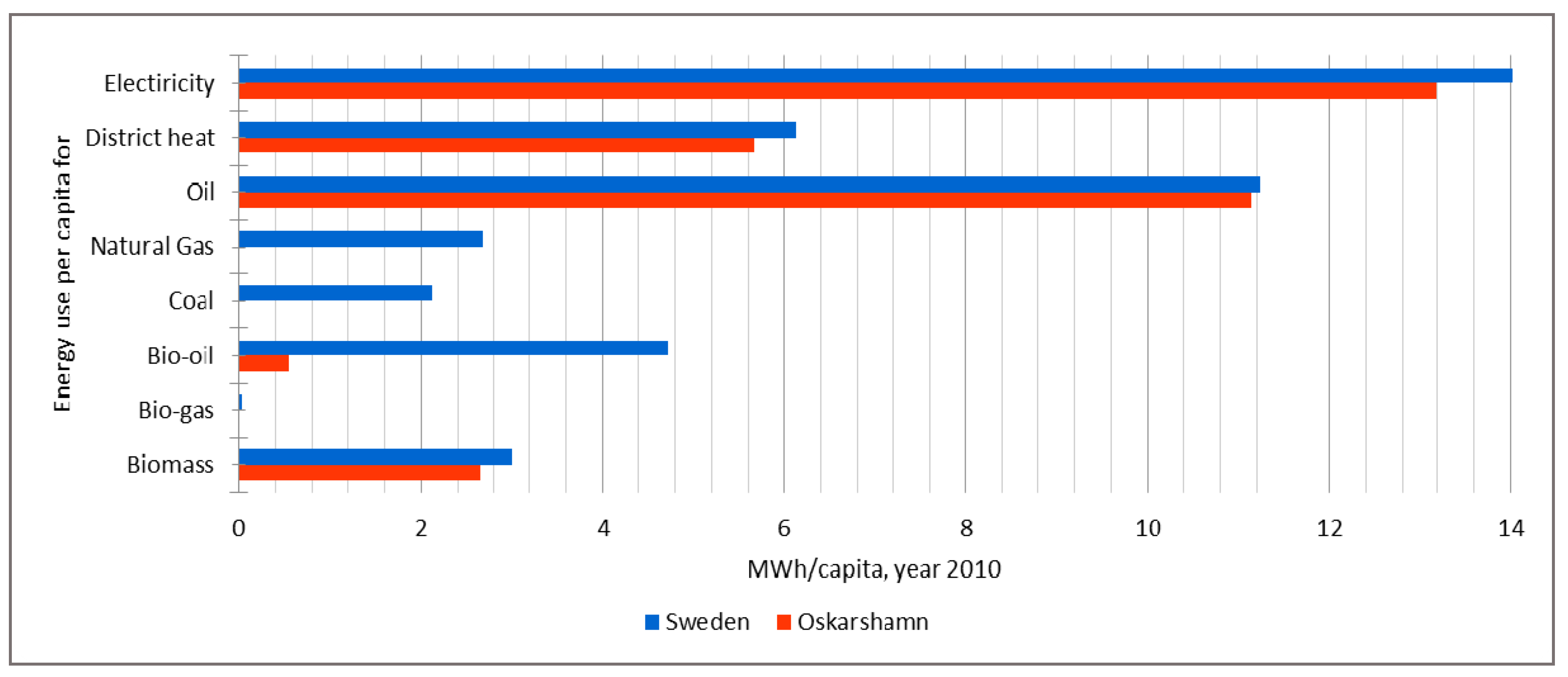
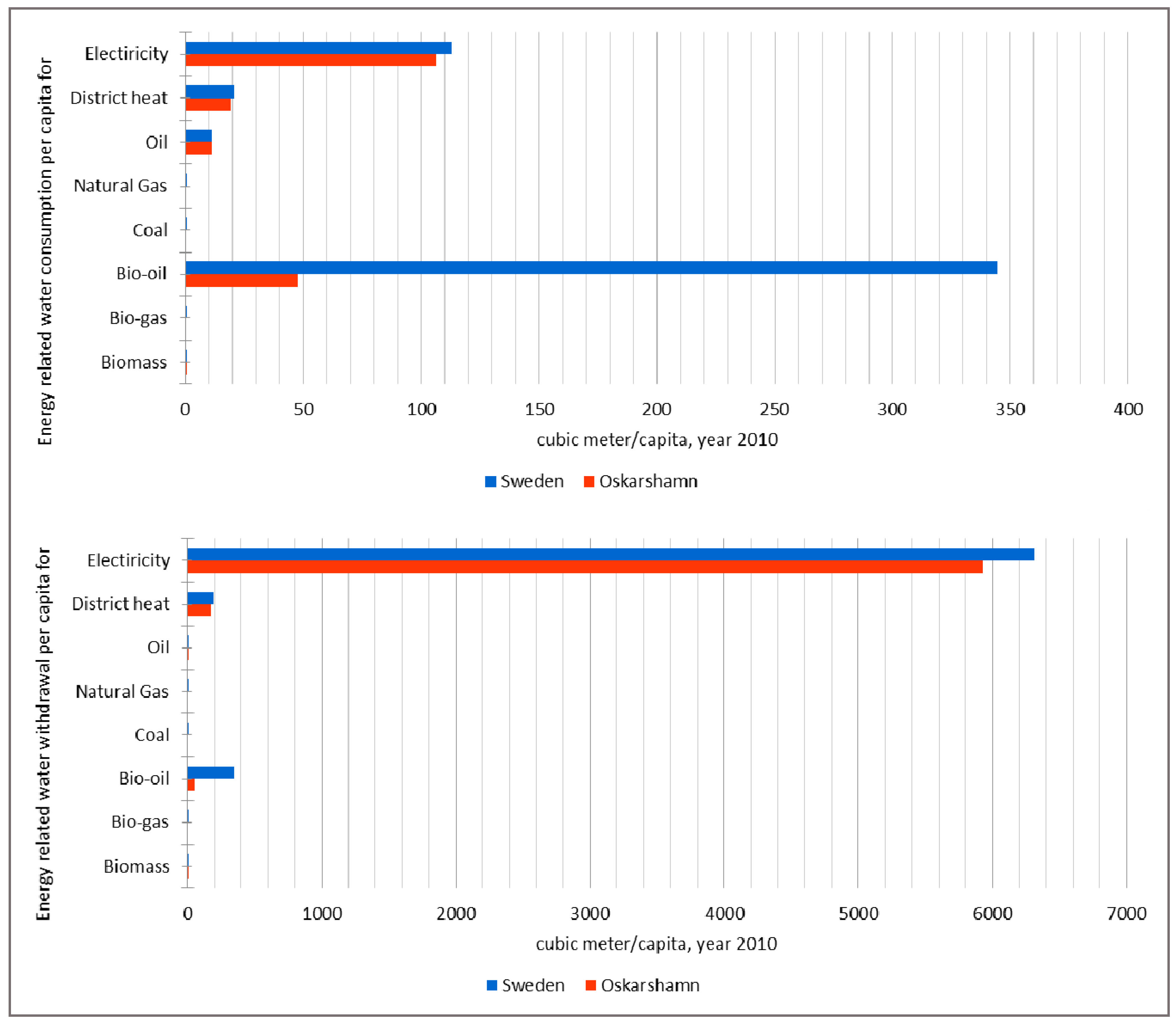
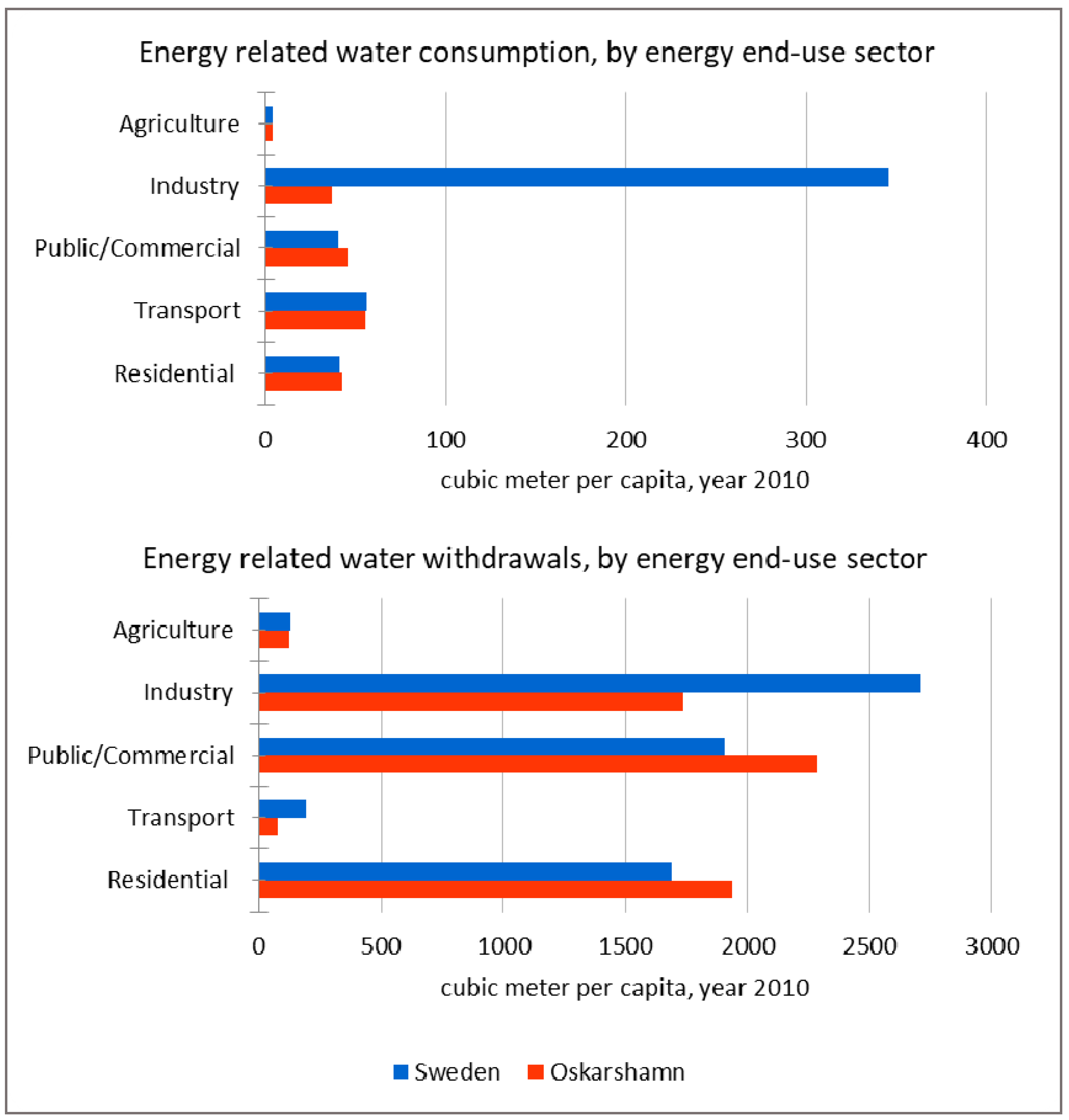
References
- UN General Assembly. Transforming Our World: The 2030 Agenda for Sustainable Development; United Nations: New York, NY, USA, 2015. [Google Scholar]
- Griggs, D.; Nilsson, M.; Stevance, A.; McCollum, D. A Guide to SDG Interactions: From Science to Implementation; International Council for Science (ICSU): Paris, France, 2017. [Google Scholar]
- International Energy Agency (IEA) & the World Bank. Sustainable Energy for All 2015—Progress toward Sustainable Energy 2015; World Bank: Washington, DC, USA, 2015. [Google Scholar] [CrossRef]
- Nilsson, M.; Griggs, D.; Visbeck, M. Policy: Map the interactions between Sustainable Development Goals. Nat. News 2016, 534, 320. [Google Scholar] [CrossRef]
- Nerini, F.F.; Tomei, J.; To, L.S.; Bisaga, I.; Parikh, P.; Black, M.; Borrion, A.; Spataru, C.; Broto, V.C.; Anandarajah, G. Mapping synergies and trade-offs between energy and the Sustainable Development Goals. Nat. Energy 2018, 3, 10–15. [Google Scholar] [CrossRef]
- Pradhan, P.; Costa, L.; Rybski, D.; Lucht, W.; Kropp, J.P. A Systematic Study of Sustainable Development Goal (SDG) Interactions. Earths Future 2017, 5, 1169–1179. [Google Scholar] [CrossRef] [Green Version]
- Covenant of Mayors. Available online: http://www.covenantofmayors.eu/index_en.html (accessed on 28 March 2017).
- Bulkeley, H.; Castán Broto, V.; Edwards, G. Bringing climate change to the city: Towards low carbon urbanism? Local Environ. Int. J. Justice Sustain. 2012, 17, 545–551. [Google Scholar] [CrossRef]
- Rosenzweig, C.; Solecki, W.; Hammer, S.A.; Mehrotra, S. Cities lead the way in climate-change action. Nature 2010, 467, 909–911. [Google Scholar] [CrossRef]
- Acuto, M. City Leadership in Global Governance. Glob. Gov. Rev. Multilater. Int. Organ. 2013, 19, 481–498. [Google Scholar] [CrossRef]
- Hussey, K.; Pittock, J. The Energy–Water Nexus: Managing the Links between Energy and Water for a Sustainable Future. Ecol. Soc. 2012, 17. [Google Scholar] [CrossRef] [Green Version]
- Engström, R.E.; Howells, M.; Destouni, G. Water impacts and water-climate goal conflicts of local energy choices—Notes from a Swedish perspective. Proc. IAHS 2018, 376, 25–33. [Google Scholar] [CrossRef]
- Pincetl, S. Nature, urban development and sustainability—What new elements are needed for a more comprehensive understanding? Cities 2012, 29 (Suppl. 2), S32–S37. [Google Scholar] [CrossRef]
- Bazilian, M.; Rogner, H.; Howells, M.; Hermann, S.; Arent, D.; Gielen, D.; Steduto, P.; Mueller, A.; Komor, P.; Tol, R.S.; et al. Considering the energy, water and food nexus: Towards an integrated modelling approach. Energy Policy 2011, 39, 7896–7906. [Google Scholar] [CrossRef]
- De Strasser, L.; Lipponen, A.; Howells, M.; Stec, S.; Bréthaut, C. A methodology to assess the water energy food ecosystems nexus in transboundary river basins. Water 2016, 8, 59. [Google Scholar] [CrossRef]
- Howells, M.; Hermann, S.; Welsch, M.; Bazilian, M.; Segerström, R.; Alfstad, T.; Gielen, D.; Rogner, H.; Fischer, G.; Van Velthuizen, H.; et al. Integrated analysis of climate change, land-use, energy and water strategies. Nat. Clim. Chang. 2013, 3, 621–626. [Google Scholar] [CrossRef]
- Macknick, J.; Sattler, S.; Averyt, K.; Clemmer, S.; Rogers, J. The water implications of generating electricity: Water use across the United States based on different electricity pathways through 2050. Environ. Res. Lett. 2012, 7, 045803. [Google Scholar] [CrossRef]
- Märker, C.; Venghaus, S.; Hake, J.-F. Integrated governance for the food–energy–water nexus—The scope of action for institutional change. Renew. Sustain. Energy Rev. 2018, 97, 290–300. [Google Scholar] [CrossRef]
- Smajgl, A.; Ward, J. The Water-Food-Energy Nexus in the Mekong Region: Assessing Development Strategies Considering Cross-Sectoral and Transboundary Impacts; Springer Science & Business Media: New York, NY, USA, 2013. [Google Scholar]
- United Nations. Prototype Global Sustainable Development Report; United Nations Department of Economic and Social Affairs, Division for Sustainable Development: New York, NY, USA, 2014. [Google Scholar]
- Destouni, G.; Jaramillo, F.; Prieto, C. Hydroclimatic shifts driven by human water use for food and energy production. Nat. Clim. Chang. 2013, 3, 213–217. [Google Scholar] [CrossRef]
- Levi, L.; Jaramillo, F.; Andricevic, R.; Destouni, G. Hydroclimatic changes and drivers in the Sava River Catchment and comparison with Swedish catchments. Ambio 2015, 44, 624–634. [Google Scholar] [CrossRef] [Green Version]
- Jaramillo, F.; Destouni, G. Comment on “Planetary boundaries: Guiding human development on a changing planet”. Science 2015, 348, 1217. [Google Scholar] [CrossRef]
- Zhou, Y.; Zhang, B.; Wang, H.; Bi, J. Drops of energy: Conserving urban water to reduce greenhouse gas emissions. Environ. Sci. Technol. 2013, 47, 10753–10761. [Google Scholar] [CrossRef]
- International Energy Agency. WEO 2016 Special Report: Water Energy Nexus; International Energy Agency: Paris, France, 2017; 63p. [Google Scholar]
- Gerbens-Leenes, P.W.; Van Lienden, A.R.; Hoekstra, A.Y.; Van der Meer, T.H. Biofuel scenarios in a water perspective: The global blue and green water footprint of road transport in 2030. Glob. Environ. Chang. 2012, 22, 764–775. [Google Scholar] [CrossRef] [Green Version]
- Pacetti, T.; Lombardi, L.; Federici, G. Water–energy Nexus: A case of biogas production from energy crops evaluated by Water Footprint and Life Cycle Assessment (LCA) methods. J. Clean. Prod. 2015, 101, 278–291. [Google Scholar] [CrossRef]
- Scown, C.D.; Horvath, A.; McKone, T.E. Water Footprint of U.S. Transportation Fuels. Environ. Sci. Technol. 2011, 45, 2541–2553. [Google Scholar] [CrossRef]
- Macknick, J.; Newmark, R.; Heath, G.; Hallett, K.C. Operational water consumption and withdrawal factors for electricity generating technologies: A review of existing literature. Environ. Res. Lett. 2012, 7, 045802. [Google Scholar] [CrossRef]
- Mekonnen, M.M.; Gerbens-Leenes, P.W.; Hoekstra, A.Y. The consumptive water footprint of electricity and heat: A global assessment. Environ. Sci. Water Res. Technol. 2015, 1, 285–297. [Google Scholar] [CrossRef]
- Jaramillo, F.; Destouni, G. Local flow regulation and irrigation raise global human water consumption and footprint. Science 2015, 350, 1248–1251. [Google Scholar] [CrossRef]
- Cheng VK, M.; Hammond, G.P. Life-cycle energy densities and land-take requirements of various power generators: A UK perspective. J. Energy Inst. 2017, 90, 201–213. [Google Scholar] [CrossRef]
- Denholm, P.; Margolis, R.M. Land-use requirements and the per-capita solar footprint for photovoltaic generation in the United States. Energy Policy 2008, 36, 3531–3543. [Google Scholar] [CrossRef]
- Fthenakis, V.; Kim, H.C. Land use and electricity generation: A life-cycle analysis. Renew. Sustain. Energy Rev. 2009, 13, 1465–1474. [Google Scholar] [CrossRef] [Green Version]
- Hermann, S.; Welsch, M.; Segerstrom, R.E.; Howells, M.I.; Young, C.; Alfstad, T.; Rogner, H.H.; Steduto, P. Climate, land, energy and water (CLEW) interlinkages in Burkina Faso: An analysis of agricultural intensification and bioenergy production. Nat. Resour. Forum 2012, 36, 245–262. [Google Scholar] [CrossRef]
- Valin, H.; Peters, D.; van den Berg, M.; Frank, S.; Havlik, P.; Forsell, N.; Hamelinck, C.; Pirker, J.; Mosnier, A.; Balkovič, J.; et al. The Land Use Change Impact of Biofuels Consumed in the EU. Quantification of Area and Greenhouse Gas Impacts; Ecofys: Utrecht, The Netherlands, 2015. [Google Scholar]
- Vattenfall AB. Certified Environmental Product Declaration EPD® of Electricity from Vattenfall’s Nordic Hydropower, UNCPC Code 17, Group 171 - Electrical Energy. Vattenfall AB, 2015. Available online: https://www.environdec.com/Detail/?Epd=11982 (accessed on 12 March 2019).
- Liu, H.; Huang, Y.; Yuan, H.; Yin, X.; Wu, C. Life cycle assessment of biofuels in China: Status and challenges. Renew. Sustain. Energy Rev. 2018, 97, 301–322. [Google Scholar] [CrossRef]
- Singlitico, A.; Goggins, J.; Monaghan, R.F.D. The role of life cycle assessment in the sustainable transition to a decarbonised gas network through green gas production. Renew. Sustain. Energy Rev. 2019, 99, 16–28. [Google Scholar] [CrossRef]
- Uctug, F.G.; Azapagic, A. Environmental impacts of small-scale hybrid energy systems: Coupling solar photovoltaics and lithium-ion batteries. Sci. Total Environ. 2018, 643, 1579–1589. [Google Scholar] [CrossRef]
- Pioletti, M.; Brigolin, D.; Pastres, R. The life cycle impact of energy final uses in small urban systems: Implications for emission accounting and EU sustainable local energy planning. Sustain. Cities Soc. 2018, 42, 252–258. [Google Scholar] [CrossRef]
- Holland, R.A.; Scott, K.A.; Flörke, M.; Brown, G.; Ewers, R.M.; Farmer, E.; Kapos, V.; Muggeridge, A.; Scharlemann, J.P.; Taylor, G.; et al. Global impacts of energy demand on the freshwater resources of nations. Proc. Natl. Acad. Sci. USA 2015, 112, E6707–E6716. [Google Scholar] [CrossRef] [Green Version]
- Howard, D.C.; Wadsworth, R.A.; Whitaker, J.W.; Hughes, N.; Bunce, R.G.H. The impact of sustainable energy production on land use in Britain through to 2050. Land Use Policy 2009, 26, S284–S292. [Google Scholar] [CrossRef]
- C40 & Ramboll. Urban Climate Action Impact Framework. A Framework for Describing and Measuring the Wider Impacts of Urban Climate Action; C40: London, UK, 2018. [Google Scholar]
- Sachs, J.; Schmidt-Traub, G.; Kroll, C.; Durand-Delacre, D.; Teksoz, K. SDG Index and Dashboards Report 2017; Bertelsmann Stiftung and Sustainable Development Solutions Network (SDSN): New York, NY, USA, 2017. [Google Scholar]
- Sachs, J.; Schmidt-Traub, G.; Kroll, C.; Lafortune, G.; Fuller, G. SDG Index and Dashboards Report 2018; Bertelsmann Stiftung and Sustainable Development Solutions Network (SDSN): New York, NY, USA, 2018. [Google Scholar]
- Sachs, J.; Schmidt-Traub, G.; Kroll, C.; Durand-Delacre, D.; Teksoz, K. SDG Index & Dashboards—Global Report; Bertelsmann Stiftung and Sustainable Development Solutions Network (SDSN): New York, NY, USA, 2016. [Google Scholar]
- Swedish Government. Sweden and the 2030 Agenda—Report to the UN High. Level Political Forum 2017 on Sustainable Development; Swedish Government: Stockholm, Sweden, 2017. Available online: https://sustainabledevelopment.un.org/content/documents/16033Sweden.pdf (accessed on 12 December 2018).
- Ganzenmüller, R.; Pradhan, P.; Kropp, J.P. Sectoral performance analysis of national greenhouse gas emission inventories by means of neural networks. Sci. Total Environ. 2019, 656, 80–89. [Google Scholar] [CrossRef]
- The EU Covenant of Mayors for Climate & Energy. Covenant of Mayors—Oskarshamn, Sweden. 2011. Available online: https://www.covenantofmayors.eu/about/covenant-community/signatories/overview.html?scity_id=5389 (accessed on 12 October 2018).
- Oskarshamns kommun. Energi och klimatprogram 2016–2020; Oskarshamns kommun: Oskarshamn, Sweden, 2016. [Google Scholar]
- Oskarshamns kommun. Vindkraft Oskarshamn Komun—Tematiskt Tillägg Till Översiktsplanen; Oskarshamns kommun: Oskarshamn, Sweden, 2011. [Google Scholar]
- Siyal, S.H.; Mörtberg, U.; Mentis, D.; Welsch, M.; Babelon, I.; Howells, M. Wind energy assessment considering geographic and environmental restrictions in Sweden: A GIS-based approach. Energy 2015, 83, 447–461. [Google Scholar] [CrossRef]
- Svenska Petroleum och Biodrivmedel Institutet. SPBI Branschfakta 2018; Svenska Petroleum och Biodrivmedel Institutet: Stockholm, Sweden, 2018. [Google Scholar]
- Swedish Energy Agency. Energy in Sweden 2017; Swedish Energy Agency: Eskilstuna, Sweden, 2018. [Google Scholar]
- OKG. “Vad är Uran?” 2018. Available online: http://www.okg.se/sv/Karnkraft/Uran/ (accessed on 26 October 2018).
- Energikontor Sydost & Biogas Sydost. Regional strategi och handlingsplan för biogas till fordon i Blekinge, Kalmar och Kronobergs län. Åtgärder 2014–2017 med utblick till 2020; Energikontor Sydost AB: Växjö, Sweden, 2014. [Google Scholar]
- Swedish Energy Agency. Biogas in Sweden—Energy source for the Future from Sustainable Waste Management; Swedish Energy Agency: Eskilstuna, Sweden, 2011. [Google Scholar]
- Johansson, D.; Gustavsson, G. Bioenergibranschen i Sydost-kartläggning, utmaningar och möjligheter; Energikontor Sydost AB: Växjö, Sweden, 2018. [Google Scholar]
- Wallmark, C.; Goldmann, M.; Berglund Odhner, P.; Forward, S.; Hoyer, K. Fossiloberoende fordonsflotta 2030 –Hur realiserar vi målet? 2030-sekretariatet: Stockholm, Sweden, 2016. [Google Scholar]
- SCB. Tillförsel och användning av el 2001–2017 (GWh) [Electronic resource] Table: EN0105A1. Statistiska Centralbyrån, 2018. Available online: http://www.scb.se/hitta-statistik/statistik-efter-amne/energi/tillforsel-och-anvandning-av-energi/arlig-energistatistik-el-gas-och-fjarrvarme/pong/tabell-och-diagram/tillforsel-och-anvandning-av-el-gwh/ (accessed on 3 December 2018).
- Swedish Energy Agency. Drivmedel och biobränslen 2015. Mängder, komponenter och ursprung rapporterade i enlighet med drivmedelslagen och hållbarhetslagen; Swedish Energy Agency: Eskilstuna, Sweden, 2016. [Google Scholar]
- IAEA. Nuclear Technology Review 2009, Annex VI: Seeking Sustainable Climate, Land, Energy and Water (CLEW) Strategies; IAEA: Vienna, Austria, 2009. [Google Scholar]
- Sridharan, V.; Broad, O.; Shivakumar, A.; Howells, M.; Boehlert, B.; Groves, D.G.; Rogner, H.H.; Taliotis, C.; Neumann, J.E.; Strzepek, K.M.; et al. Resilience of the Eastern African electricity sector to climate driven changes in hydropower generation. Nat. Commun. 2019, 10, 302. [Google Scholar] [CrossRef]
- Engström, R.E.; Howells, M.; Destouni, G.; Bhatt, V.; Bazilian, M.; Rogner, H.H. Connecting the resource nexus to basic urban service provision—With a focus on water-energy interactions in New York City. Sustain. Cities Soc. 2017, 31, 83–94. [Google Scholar] [CrossRef]
- Heaps, C.G. Long-Range Energy Alternatives Planning (LEAP) System [Software Version 2015.0.14]; Stockholm Environment Institute: Somerville, MA, USA, 2012. [Google Scholar]
- IPCC. 2006 IPCC Guidelines for National Greenhouse Gas. Inventories, Prepared by the National Greenhouse Gas. Inventories Programme; Eggleston, H.S., Buendia, L., Miwa, K., Ngara, T., Tanabe, K., Eds.; IGES: Tokyo, Janpan, 2006. [Google Scholar]
- Meldrum, J.; Nettles-Anderson, S.; Heath, G.; Macknick, J. Life cycle water use for electricity generation: A review and harmonization of literature estimates. Environ. Res. Lett. 2013, 8, 015031. [Google Scholar] [CrossRef]
- Lo, E. Gaussian Error Propagation Applied to Ecological Data: Post-Ice-Storm-Downed Woody Biomass. Ecol. Monogr. 2005, 75, 451–466. [Google Scholar] [CrossRef]
- Ramaswamy, V. Oskarshamn—A Smart Energy Island Assessment. MSc Thesis, Royal Institute of Tecnolgoy, Stockholm, Sweden, urn:nbn:se:kth:diva-182669. 2015. Available online: http://urn.kb.se/resolve?urn=urn:nbn:se:kth:diva-182669 (accessed on 12 March 2019).
- Ozcan, B.; Ozturk, I. A new approach to energy consumption per capita stationarity: Evidence from OECD countries. Renew. Sustain. Energy Rev. 2016, 65, 332–344. [Google Scholar] [CrossRef]
- SCB. ‘Bruttoregionprodukt (BRP), efter region, tabellinnehåll och år’ [Electronic resource] Table ENS2010. Statistikdatabasen, 2017. Available online: http://www.statistikdatabasen.scb.se/pxweb/sv/ssd/START__NR__NR0105__NR0105A/NR0105ENS2010T06A/table/tableViewLayout1/?rxid=fdde33d3-5f59-4592-97e5-6d720b325163 (accessed on 6 November 2018).
- SCB. ‘Folkmängd efter år och region’ [Electronic Resource], Table BE0101N1. Statistikdatabasen, 2016. Available online: http://www.statistikdatabasen.scb.se/pxweb/sv/ssd/START__BE__BE0101__BE0101A/BefolkningNy/table/tableViewLayout1/?rxid=fdde33d3-5f59-4592-97e5-6d720b325163# (accessed on 6 November 2018).
- SCB. ‘Markanvändningen i Sverige, hektar efter region, markanvändningsklass och vart 5:e år’ [Electronic resource], Table MI0803AB. 2018. Available online: http://www.statistikdatabasen.scb.se/pxweb/sv/ssd/START__MI__MI0803__MI0803A/MarkanvKn/table/tableViewLayout1/?rxid=3b19bd10-6172-4a42-a0aa-28990c226a65 (accessed on 13 December 2018).
- Leufstadius, H. Uppföljning av fördubblingsmålet 2015. Rapport från Partnersamverkan för en förbättrad kollektivtrafik; Sweco Transportsystem: Stockholm, Sweden, 2015. [Google Scholar]
- Trygg, L. Swedish Industrial and Energy Supply Measures in a European System Perspective; Linköping University: Linköping, Sweden, 2006. [Google Scholar]
- Gjorgiev, B.; Sansavini, G. Water-energy nexus: Impact on electrical energy conversion and mitigation by smart water resources management. Energy Convers. Manag. 2017, 148, 1114–1126. [Google Scholar] [CrossRef]
- Herath, I.; Deurer, M.; Horne, D.; Singh, R.; Clothier, B. The water footprint of hydroelectricity: A methodological comparison from a case study in New Zealand. J. Clean. Prod. 2011, 19, 1582–1589. [Google Scholar] [CrossRef]
- Mielke, E.; Anadon, L.D.; Narayanamurti, V. Water Consumption of Energy Resource Extraction, Processing, and Conversion; Belfer Center for Science and International Affairs: Cambridge, MA, USA, 2010. [Google Scholar]
- Gerbens-Leenes, P.W.; Hoekstra, A.Y.; Meer, T.H. Water Footprint of Bio-Energy and Other Primary Energy Carriers; (UNESCO-IHE Institute for Water Education: Delft, The Netherlands, 2008. [Google Scholar]
- Spang, E.S.; Moomaw, W.R.; Gallagher, K.S.; Kirshen, P.H.; Marks, D.H. The water consumption of energy production: An international comparison. Environ. Res. Lett. 2014, 9, 105002. [Google Scholar] [CrossRef]
- Yeh, S.; Jordaan, S.M.; Brandt, A.R.; Turetsky, M.R.; Spatari, S.; Keith, D.W. Land use greenhouse gas emissions from conventional oil production and oil sands. Environ. Sci. Technol. 2010, 44, 8766–8772. [Google Scholar] [CrossRef]
- SCB. ‘Slutanvändning (MWh), efter län och kommun, förbrukarkategori samt bränsletyp. År 2009–2016’ [Electronic Resource], Table EN0203AE. Statistikdatabasen, 2018. Available online: http://www.statistikdatabasen.scb.se/pxweb/sv/ssd/START__EN__EN0203/SlutAnvSektor/ (accessed on 5 November 2018).
- Seckler, D.; Amarasinghe, U. Water Supply and Demand, 1995 to 2025; IWMI: Colombo, Sri Lanka, 2000. [Google Scholar]
- Oskarshamns Kommun. Vatten- och avloppsplan för Oskarshamns kommun; Oskarshamns kommun: Oskarshamn, Sweden, 2015. [Google Scholar]
- SCB. ‘Bebyggd mark efter region och markanvändningsklass. Vart 5:e år 2010-2015.’ [Electronic resource] Table MI0803AC. 2016. Available online: http://www.statistikdatabasen.scb.se/pxweb/sv/ssd/START__MI__MI0803__MI0803A/MarkanvBebyggdLnKn/table/tableViewLayout1/?rxid=3b19bd10-6172-4a42-a0aa-28990c226a65 (accessed on 15 December 2017).
- Ahlgren, S.; Björnsson, L.; Prade, T.; Lantz, M. Biofuels from Agricultural Biomass—Land Use Change in Swedish Perspective; f3 The Swedish Knowledge Centre for Renewable Transportation Fuels: Gothenburg, Sweden, 2017. [Google Scholar]
- Covenant of Mayors. EU Covenant of Mayors Commitment Document; Covenant of Mayors: Brussels, Belgium, 2018.
- Fraiture, C.D.; Giordano, M.; Liao, Y. Biofuels and implications for agricultural water use: Blue impacts of green energy. Water Policy 2008, 10, 67–81. [Google Scholar] [CrossRef]
- Denholm, P.; Hand, M.; Jackson, M.; Ong, S. Land Use Requirements of Modern Wind Power Plants in the United States; National Renewable Energy Lab. (NREL): Golden, CO, USA, 2009. [Google Scholar] [CrossRef]
- Drewitt, A.L.; Langston RH, W. Assessing the impacts of wind farms on birds. IBIS 2006, 148, 29–42. [Google Scholar] [CrossRef] [Green Version]
- Kuvlesky, W.P., Jr.; Brennan, L.A.; Morrison, M.L.; Boydston, K.K.; Ballard, B.M.; Bryant, F.C. Wind Energy Development and Wildlife Conservation: Challenges and Opportunities. J. Wildl. Manag. 2007, 71, 2487–2498. [Google Scholar] [CrossRef]
- Lusseau, D.; Mancini, F. Income-based variation in Sustainable Development Goal interaction networks. Nat. Sustain. 2019, 2, 242. [Google Scholar] [CrossRef]
- Sridharan, V.; Howells, M.; Ramos, E.P.; Sundin, C.; Almulla, Y.; Fuso-Nerini, F. The Climate-Land-Energy and Water Nexus: Implications for Agricultural Research. CGIAR Science Forum 2018: Background Paper. 2018. Available online: https://www.scienceforum2018.org/sites/default/files/2018-10/SF18_background_paper_Sridharan_2.pdf (accessed on 15 February 2019).
- Ellis, M.; Jolland, N. Gadgets and Gigawatts: Policies for Energy Efficient Electronics; IEA: Paris, France, 2009. [Google Scholar]
- Hager, T.J.; Morawicki, R. Energy consumption during cooking in the residential sector of developed nations: A review. Food Policy 2013, 40, 54–63. [Google Scholar] [CrossRef]
- Balsys, R.; Otas, K.; Mikulionis, A.; Pakėnas, V.J.; Vaškys, A.; Vitta, P.; Žukauskas, A. Street lighting power reduction potential in Lithuanian cities. In Urban Street Design & Planning; WIT Press: Southampton, UK, 2013. [Google Scholar]
- Merkisz, J.; Fuć, P.; Lijewski, P.; Kozak, M. Rapeseed Oil Methyl Esters (RME) as Fuel for Urban Transport. Altern. Fuels Tech. Environ. Cond. 2016. [Google Scholar] [CrossRef] [Green Version]
- Rio Carrillo, A.M.; Frei, C. Water: A key resource in energy production. Energy Policy 2009, 37, 4303–4312. [Google Scholar] [CrossRef] [Green Version]
- Mekonnen, M.M.; Hoekstra, A.Y. The blue water footprint of electricity from hydropower. Hydrol. Earth Syst. Sci. 2012, 16, 179–187. [Google Scholar] [CrossRef] [Green Version]
- Swedish Radiation Safety Authority. Så fungerar en kokvattenreaktor; Swedish Radiation Safety Authority: Solna, Sweden, 2013. [Google Scholar]
- Union of Concerned Scientists. UCS EW3 Energy-Water Database V.1.3; Union of Concerned Scientists: Cambridge, MA, USA, 2012. [Google Scholar]
- Swedenenergy. Fjärrvärmestatistik—Energiföretagen Sverige. 2015. Available online: http://www.svenskfjarrvarme.se/Statistik--Pris/Fjarrvarme/Energitillforsel/ (accessed on 11 December 2017).
- Vattenfall AB. Certified Environmental Product Declaration EPD® of Electricity from Vattenfall Nordic Nuclear Power Plants, UNCPC Code 17, Group 171 - Electrical Energy. Vattenfall AB, 2016. Available online: https://www.environdec.com/Detail/?Epd=11982 (accessed on 12 March 2019).
- Granit, J.; Lindström, A. Constraints and opportunities in meeting the increasing use of water for energy production. In Proceedings of the ESF Strategic Workshop on: Accounting for Water Scarcity and Pollution in the Rules of International trade, Amsterdam, The Netherlands, 25–26 November 2010; UNESCO-IHE Institute for Water Education: Delft, The Netherlands, 2010. [Google Scholar]
- Katers, J.F.; Snippen, A. Life-Cycle Inventory of Wood Pellet Manufacturing in Wisconsin; Public Service Commission of Wisconsin & the Statewide Energy Efficiency and Renewables Administration: Madison, WI, USA, 2011; 43p. [Google Scholar]
- Gómez, A.; Rodrigues, M.; Montañés, C.; Dopazo, C.; Fueyo, N. The potential for electricity generation from crop and forestry residues in Spain. Biomass Bioenergy 2010, 34, 703–719. [Google Scholar] [CrossRef]
- Miljösamverkan Västra Götaland. Vägledning för miljötillsyn vid fjärrvärmeanläggningar; Miljösamverkan Västra Götaland: Borås, Sweden, 2007. [Google Scholar]
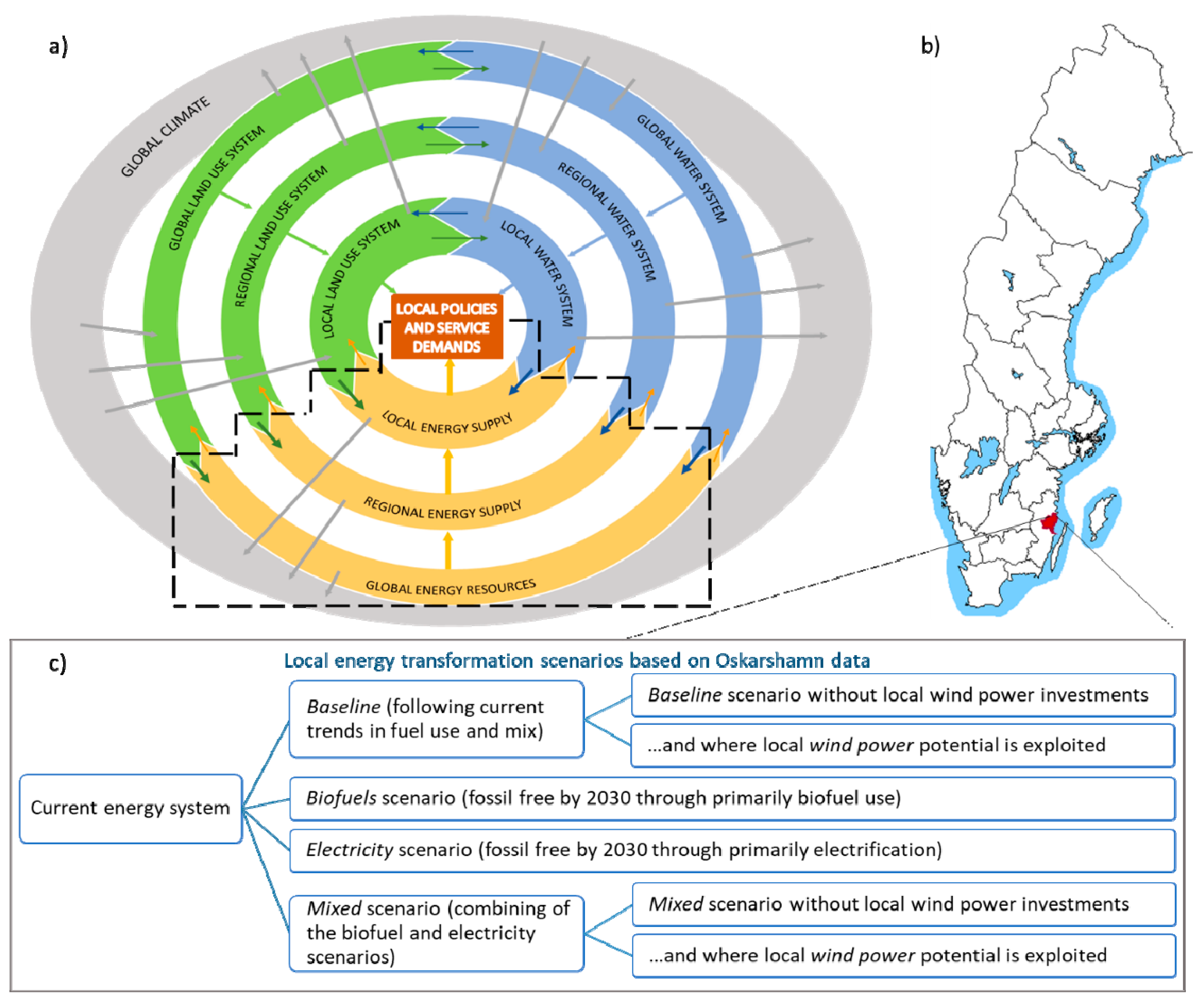

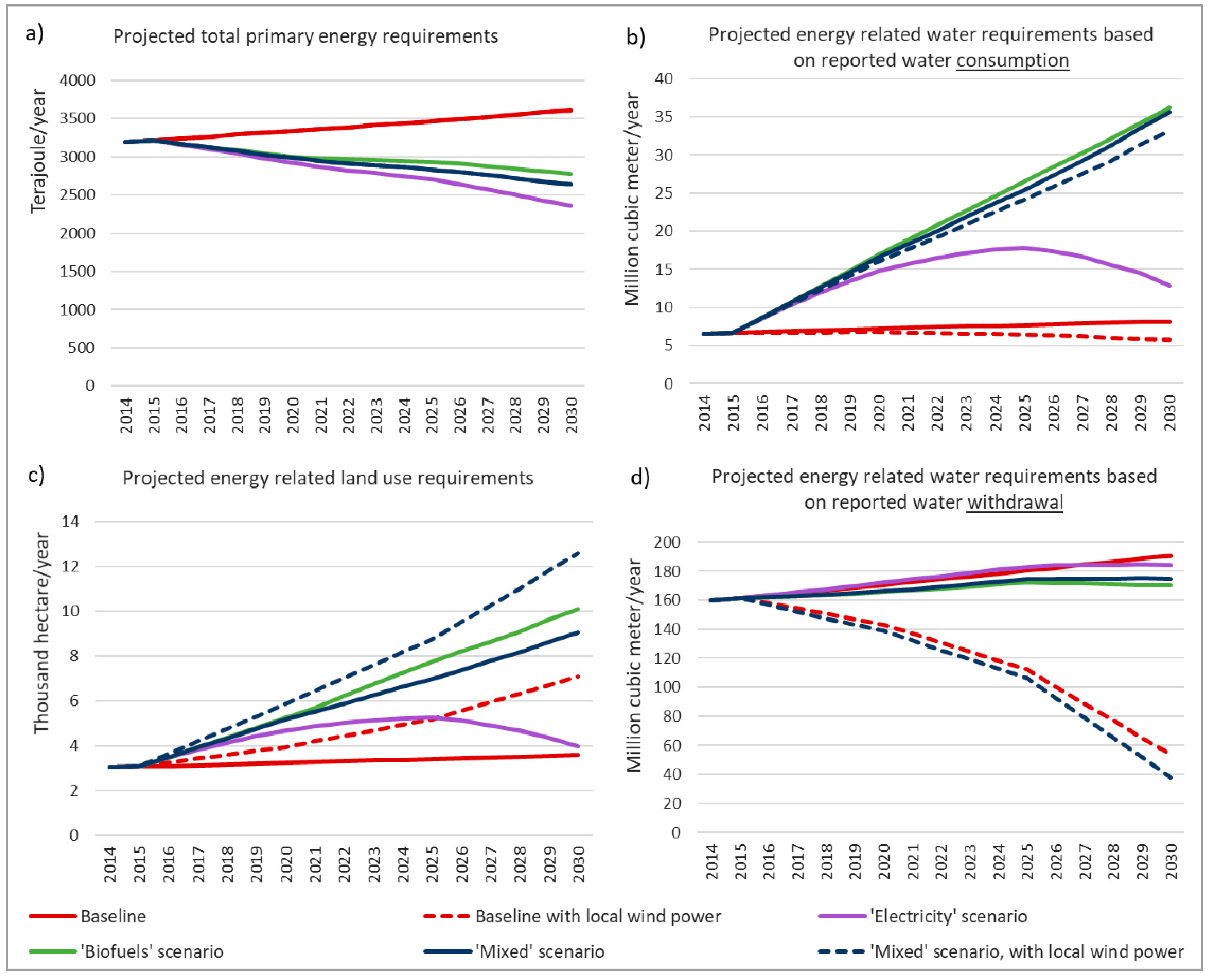
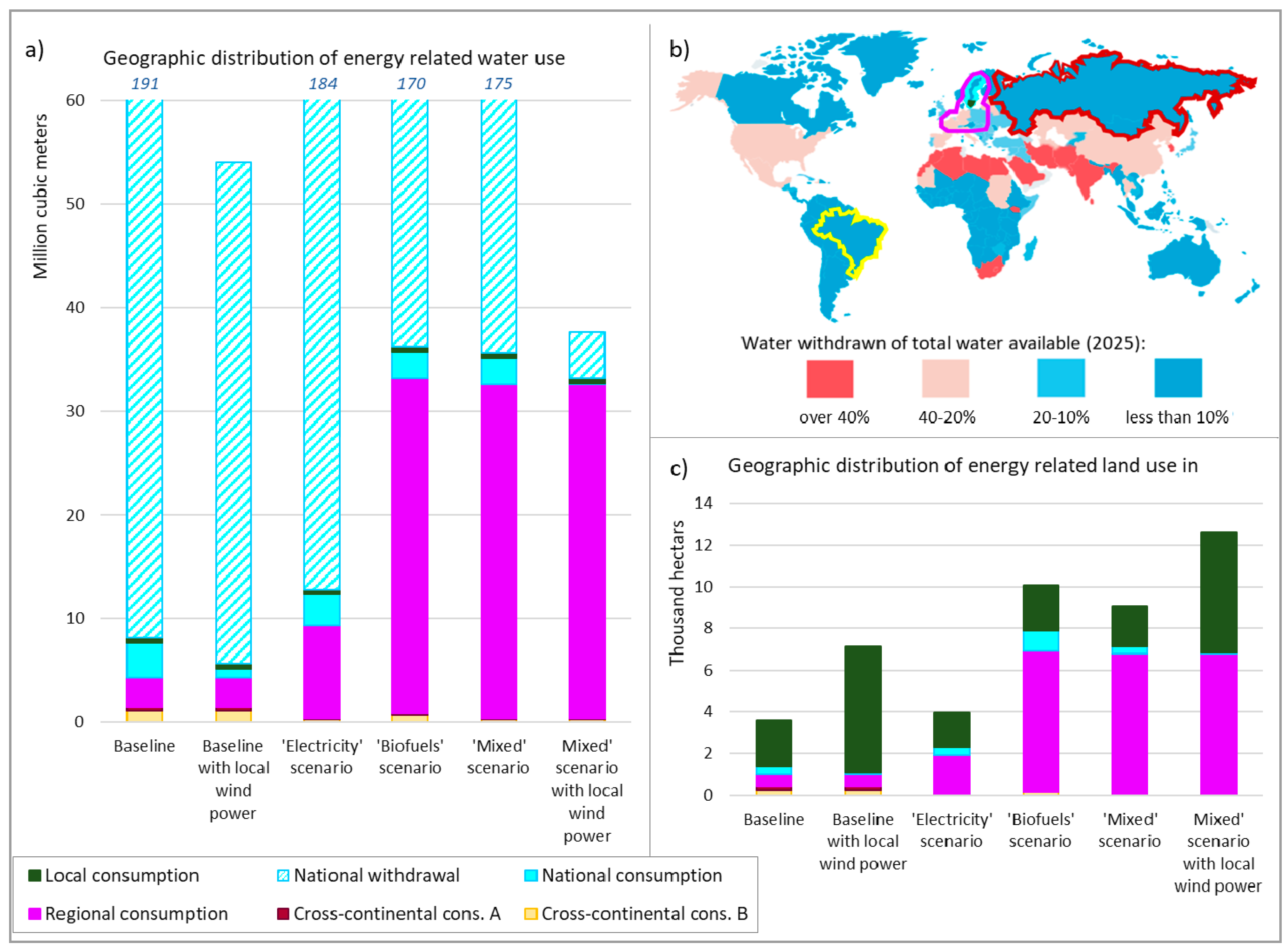
| Fuel Group | Primary Geographic Origin | Reference |
|---|---|---|
| Crude oil—refined to heating oil, gasoline and diesel | Russia | [54] |
| Electricity (incl. (nuclear *) fuel extraction) | Sweden (Canada) | [37,55,56] |
| Wind power | Oskarshamn | [52] |
| Biogas (if imported) | Oskarshamn (Sweden) | [57,58] |
| Biomass | Oskarshamn | [59] |
| Ethanol from sugar cane | Brazil | [36] |
| Biodiesel from rapeseed | EU (Sweden and Germany) | [36,60] |
| Key Measures of Change between Year 2012 and Year 2030 | Measure Taken in… | |
|---|---|---|
| 1 | Increased energy efficiency in residential and commercial buildings related to cooking (20%), lighting (85%) and electrical appliances (50%). | All fossil free scenarios |
| 2 | Improved insulation in residential and commercial buildings, decreasing final space heating demands (20%) | All fossil free scenarios |
| 3 | Moderate increase in the share of solar panels on residential and commercial buildings for space and water heating demands (share in 2030: detached houses 8%; apartments 4%; commercial buildings 4%). | All fossil free scenarios |
| 4 | Increased share of biomass based (>80% of input fuels) district heating to meet space and water heat demands in commercial buildings (from 20% in 2012 to 38% in 2030). | ‘Biofuels’ scenario |
| 5 | Increased share of heat pumps to meet space and water heat demands in residential and commercial buildings (from 50% to 65% in detached houses; from 58% to 76% in commercial buildings) | ‘Electricity’ scenario |
| 6 | Energy efficiency of street lighting is improved (75%) | All fossil free scenarios |
| 7 | Decoupling GDP growth with industrial energy use, decreasing overall industrial energy demands (38%) | All fossil free scenarios |
| 8 | A shift from fossil fuel based process heat in the industrial sector to equal shares of electricity powered heating and biomass (>80% of input fuels) based district heating. * | ‘Electricity’ scenario |
| 9 | A shift from fossil fuel based process heat in the industrial sector to biomass (>80% of input fuels) based district heating (89%) and electricity (11%). * | ‘Biofuels’ and ‘mixed’ scenarios |
| 10 | All fossil diesel is replaced with biodiesel in the agricultural sector. | All fossil free scenarios |
| 11 | Public transport reaches a 15% market share by 2026 (the county’s goal is to reach this in 2020 [75], but a recent decrease in number of buses in Oskarshamn is estimated by the authors to delay this goal by 6 years) | All fossil free scenarios |
| 12 | A small share of personal vehicle transports (4%) are removed from the system, assumed to be replaced by biking and walking. | All fossil free scenarios |
| 13 | Total freight transport (in vehicle-kilometres per vehicle) is reduced by 10% through improved physical planning and route optimisation in the municipality. | All fossil free scenarios |
| 14 | All fossil diesel is replaced with biodiesel in the municipal freight transport. | ‘Biofuels’ and ‘mixed’ scenarios |
| 15 | The municipal freight transport largely is electrified. Fossil diesel is replaced by biodiesel in 20% of the heavy-duty transport, where electrification is considered unfeasible. | ‘Electricity’ scenario |
| 16 | Fossil fuelled personal vehicles are replaced by predominantly biodiesel, ethanol and biogas (33 % of personal vehicles electrified in 2030, the remainder fuelled with biofuels) | ‘Biofuels’ scenario |
| 17 | Fossil fuelled personal vehicles are replaced by predominantly electric vehicles (95% of personal vehicles electrified in 2030, the remainder fuelled with liquid biofuels and biogas). | ‘Electricity’ and ‘mixed’ scenario |
| 18 | The assessed municipal wind power potential [53] is fully exploited, to cover 87% of municipal electricity demands. ** | Scenarios with local wind power |
| Water Related SDG Targets/Indicators | Land Related SDG Targets/Indicators | |||||
|---|---|---|---|---|---|---|
| 6.4 By 2030, substantially increase water-use efficiency across all sectors and ensure sustainable withdrawals and supply of freshwater to address water scarcity and substantially reduce the number of people suffering from water scarcity | 2.4 By 2030, ensure sustainable food production systems (…) that increase productivity and production, (…) | 15.1 (…) ensure the conservation, restoration and sustainable use of terrestrial (…) ecosystems and their services (…) | 15.3 (…) combat desertification, restore degraded land and soil (…) and strive to achieve a land degradation-neutral world | |||
| 6.4.1: Change in water-use efficiency over time | 6.4.2: Level of water stress… * | 2.4.1: Proportion of agricultural area under productive and sustainable agriculture | 15.1.1: Forest area as a proportion of total land area | 15.3.1: Proportion of land that is degraded over total land area | ||
| Local Decarbonisation scenarios, supporting SDGs 7, 11 and 13 | ‘Electricity’ scenario | The least ** water consuming scenario, while meeting the same final energy demand. | Highest ** water withdrawal (but primarily in Sweden—projected to remain a water rich region). | Lowest ** land-use impact and little change compared to ‘Baseline’. Moderate increase in biofuel use may cause a shift from food to fuel crops. | Lowest ** land-use impact and little change compared to ‘Baseline’. Moderate increase in biofuel use may encroach on forests. | Lowest ** overall land-use impact, indicating least impact on land degradation. |
| ‘Biofuels’ scenario | The most ** water consuming (primarily related to imported biodiesel) scenario. | Large imports of biodiesel from moderately water stressed EU countries. | Large increase in biofuel demands, that may require shifts from food to fuel crops. | As land requirements for biofuels increase, forest area may decrease. | Increased use for heating requires more forestry residues and may compete with biodiversity needs. | |
| ‘Mixed’ scenario | High water consumption, primarily related to imported biodiesel. | Large imports of biodiesel from moderately water stressed EU countries | Large increase in biofuel demands, that may require shifts from food to fuel crops | As land requirements for biofuels increase, forest area may decrease. | Increased use for heating requires more forestry residues and may compete with biodiversity needs. | |
| ‘Mixed’ scenario with local wind power | High water consumption related to imported biodiesel. | Lowest ** total water withdrawal when thermal and hydropower decrease in favour of wind power | As above, but may also be affected by wind power’s land use. | As above, but may also be affected by wind power’s land use. | As above, and scenario with the largest overall land use. ** | |
© 2019 by the authors. Licensee MDPI, Basel, Switzerland. This article is an open access article distributed under the terms and conditions of the Creative Commons Attribution (CC BY) license (http://creativecommons.org/licenses/by/4.0/).
Share and Cite
Engström, R.E.; Destouni, G.; Howells, M.; Ramaswamy, V.; Rogner, H.; Bazilian, M. Cross-Scale Water and Land Impacts of Local Climate and Energy Policy—A Local Swedish Analysis of Selected SDG Interactions. Sustainability 2019, 11, 1847. https://doi.org/10.3390/su11071847
Engström RE, Destouni G, Howells M, Ramaswamy V, Rogner H, Bazilian M. Cross-Scale Water and Land Impacts of Local Climate and Energy Policy—A Local Swedish Analysis of Selected SDG Interactions. Sustainability. 2019; 11(7):1847. https://doi.org/10.3390/su11071847
Chicago/Turabian StyleEngström, Rebecka Ericsdotter, Georgia Destouni, Mark Howells, Vivek Ramaswamy, Holger Rogner, and Morgan Bazilian. 2019. "Cross-Scale Water and Land Impacts of Local Climate and Energy Policy—A Local Swedish Analysis of Selected SDG Interactions" Sustainability 11, no. 7: 1847. https://doi.org/10.3390/su11071847
APA StyleEngström, R. E., Destouni, G., Howells, M., Ramaswamy, V., Rogner, H., & Bazilian, M. (2019). Cross-Scale Water and Land Impacts of Local Climate and Energy Policy—A Local Swedish Analysis of Selected SDG Interactions. Sustainability, 11(7), 1847. https://doi.org/10.3390/su11071847






